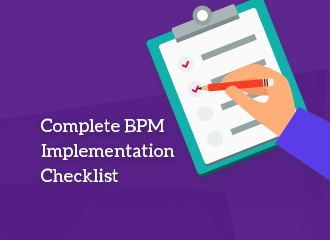
- >
- BPM Software >
- 10-Step Business Process Management (BPM) Implementation Checklist
10-Step Business Process Management (BPM) Implementation Checklist
As a CIO or BTP, inheriting the task of implementing a business process management (BPM) system can be quite challenging, especially when the project has been prolonged, and management's patience is wearing thin. The urge to deliver results swiftly can be immense, but succumbing to this pressure may not be the best course of action.
Your predecessor might have chosen a BPM platform, but hastily forcing it into operation is not advisable. Effective BPM implementation requires careful consideration and diligent effort. Rushing through the process could lead to poor adoption rates, operational inefficiencies, and overall chaos.
Rapid BPM implementation can cause project delays, disrupt existing systems, and drain your organization's resources. As technology leaders, it's crucial to balance the need for speed with the importance of thorough and thoughtful implementation. This approach will help ensure that the BPM system effectively streamlines processes and delivers the intended benefits.
Well-designed BPM practice play a key role in minimizing growing pains by helping employees to navigate complex processes, increasing visibility into work queues, preserving as well as organizing institutional knowledge, and reducing reliance on email-based processes.
- John Stretton, associate director, process automation at EDP Renewables
Streamline Your Business Process With Kissflow
Here is a 10-point Business Process Management Implementation Checklist:
1. Choose Your BPM Platform Wisely
Before you start creating processes, make sure you are building on a good foundation. The enterprise market is oversaturated with BPM and automation tools that tout everything from automatic collaboration to fixing broken processes. Make sure that your BPM tool has all of the most important BPM features.
Some BPM tools are designed to offer application development capabilities, while many others are built for visibility and process tracking. Look for a solution that everyone on the team can use, including non-technical business users. Choosing an easy-to-use BPM can save you from hiring expensive consultants to troubleshoot integration and operational issues.
2. Pick a Process to Test on
While you may be tempted to try to automate the mammoth of a process that is wreaking the most havoc, the first process you automate when implementing a BPM solution should be one that is a little easier to manage and where the risks are lower.
Until your teams are largely comfortable with the BPM tool, refrain from implementing it on mission-critical processes. Test it first on small processes like purchase orders, travel reimbursements, or other easily manageable projects. Once the process owners gain confidence about controlling the BPM better, slowly scale up the workflow to include major projects.
3. Identify the Process Owner
When integrating a new software to your enterprise portfolio it can soon become disputed land for all teams. Everyone points fingers at each other if there is no one delegated to manage the implementation process and the BPM operations.
For a BPM implementation, it is essential that you identify a process owner, usually the business lead in charge of the process. This person is accountable for the smooth functioning and organization of the process and data. That’s why it’s important to choose a human-centric BPM software solution that all of your business leads can feel comfortable with.
Sit with the process owner and talk through the current handling of the process and what he or she might be looking for from automation.
Check out why these BPM Tools are at the top of the competition!
4. Set Benchmarks
If you don’t have any enterprise goals associated with the BPM implementation, it will be an aimless endeavor and a waste of resources. Keep the ‘why’ of automating your process in mind before you trigger any workflow. Some workflows are designed to cut time and shave spending, other process are set up for better tracking or getting rid of paper trails.
Identify the most important priority in a workflow and don’t attempt to achieve multiple goals all at once. Tie a workflow to a specific objective that you are planning to accomplish and within the timeframe you want them achieved.
Start with making sense of the data from the previous processes such as emails, phone calls, or chats with customer. Be clear about the optimal time taken to finish each task under normal conditions, and use that information to set reasonable goals for the BPM platform to achieve.

Unlock the Power of Comprehensive BPM Tools: Scale, Succeed, and Stay Ahead
Thanks for submitting the form.
5. Diagram the Workflow
One key point in any BPM implementation is sitting down to diagram what the workflow will look like. Start with a simple piece of paper rather than with software. All the process owner to describe the ideal way the process should run and draw up a representation of it.
Talk with other people closest to the process and ask how the tasks were managed in the past. It’s important to understand the history of a process and any big changes they have gone through rather than basing your decisions on assumptions.
It is usually at this stage that the Process Owner will identify redundant tasks or start to see what is possible with automation. What was once a task that was ‘collect the data and email it to the project lead’ can be completely eliminated by a simple automated step.
Keep the process minimal so that the hassles of manual processes don’t creep into the system. The shorter the process route, the higher the chances of BPM’s success.
6. Involve everyone
A BPM system is run by two groups:
- Technical admins who know how to use the BPM platform
- Functional or business owners who know how the process should run
In order to encourage collaboration on the new BPM platform, involve all stakeholders in the process early on. Meet with each task owner and find out what data he or she needs. Get feedback from end users to understand pain points.
–> Thinking of BPM, but unsure which way to use it? We’ve written about choosing the right BPM methodology here.
7. Pilot your BPM workflow
The best way to understand a BPM’s impact on your business process without interfering with your ongoing processes is to run it on a pilot test. Take this opportunity to train people or fiddle with the BPM software solution’s features without risking anything.
A BPM system has to sift through a bulk of business logic when performing, and testing the tool can help you figure out the actual system runtime, its bandwidth to handle process workloads, agility, and output. Upon initial success, bigger projects that require granular control can be modelled after these processes.
8. Be Ready to Change
Traditionally-built BPM methodology focuses on structure and system rigidness, which is why only the elite club of IT personnel were only able to make changes to it.
With the rapid adoption of cloud computing and Software as a Service (SaaS), businesses today need a BPM software that meshes well with their existing system and can be tuned for better integration. You wouldn’t want to pick a BPM tool that demands the overhaul of your existing process of the IT architecture. Pick a resource-friendly and flexible BPM solution that adds more value to your ongoing processes.
Do you know these 7 compelling reasons to go for cloud BPM?
9. Train Users
The success of your BPM implementation depends hugely on how humans in the process interact with the system. BPM requires every participant to be accountable for the process being carried out, and the best way to achieve this objective is by coaching your staff.
Conduct a workshop about the basics of the BPM platform, the rationale behind its implementation, and the results expected.
10. Measure and Adjust
You will never know if automation is actually spinning up your deliverables if you don’t gauge the ROI of the BPM software solution. The role of measuring and improving a process should sit with the Process Owner, but as the system administrator, you will want to support with as much help as you can.
Usually, BPM software solutions are hard to measure because their data is more vague compared to other resources in an enterprise. But if you determine what specific types of data you want to look at, you can use key performance indicators (KPIs) to break them down and make improvements.
If you see that optimum goals are not met, reengineer the BPM to ascertain expected goals. It takes a while for every BPM tool to evolve and fit well with an enterprise processes. Until then, you should rinse and repeat the system to make the most of it.
BPM implementations can be notoriously long and complex and involve way too many people. However, when done right using a BPM platform like Kissfow Process that is human-centric, your BPM implementation will be a huge success. Remember to take things slow and plan out the idea path for a process and allow the system to handle the rest.
How Damamax crushed chaos with BPM technology
Damamax, a telecommunications provider established in 2008, faced challenges with its IT infrastructure. Their system struggled to support complex workflows, and the team was overwhelmed with requests for workflow enhancements. The existing tools were complicated, and the system lagged significantly.
Damamax discovered Kissflow, a cloud-based Business Process Management (BPM) platform, in their quest for a solution. It was an immediate fit, offering easy-to-use features that boosted productivity and provided control over their processes. The COO found value in the productivity enhancement and the insightful reports generated by the platform.
Kissflow's customizable forms and centralized data repository provided Damamax with a clear view of its operations, enabling it to identify areas for improvement. This led to significant benefits, including saving the IT team from burnout, eliminating manual processes, and saving time, effort, and money.
Damamax has since expanded its workflow automation to include purchase requests, sales leads, and HR functions like leave requests, with many functions now being 100 percent automated. They continue to seek ways to improve productivity across their organization using Kissflow.
Enhance your business with Kissflow BPM Suite
BPM implementations can be notoriously long and complex and involve way too many people. By adopting the right business automation software, organizations can connect people, processes, and data to work seamlessly together. This not only reduces bottlenecks but also creates a more agile environment that can quickly adapt to changing business needs.
However, when done right using a platform like Kissfow, your BPM implementation will be a huge success. Remember to take things slow, plan out the ideal path for a process, and allow the system to handle the rest.
Streamline Your Workflow Process With Kissflow
Related Articles
.webp?width=285&height=570&name=BPM%20leader-1%20(1).webp)











